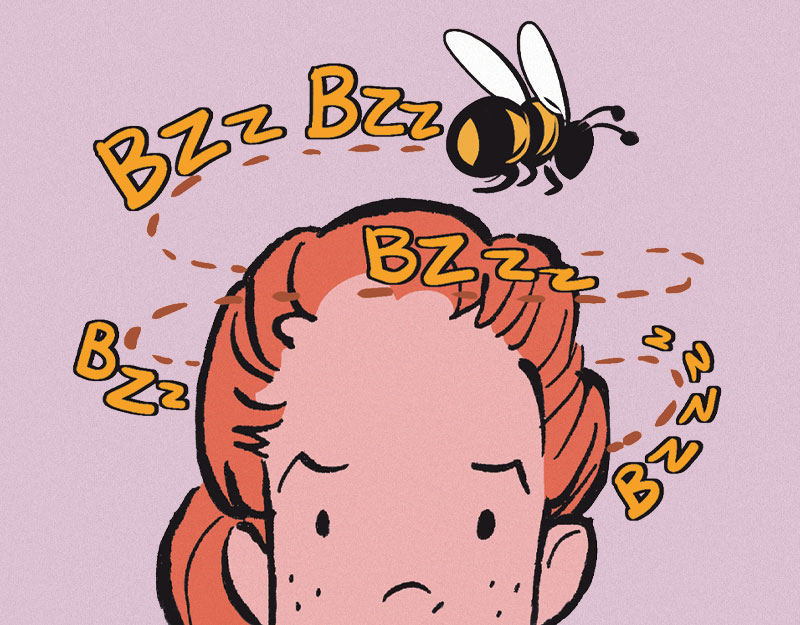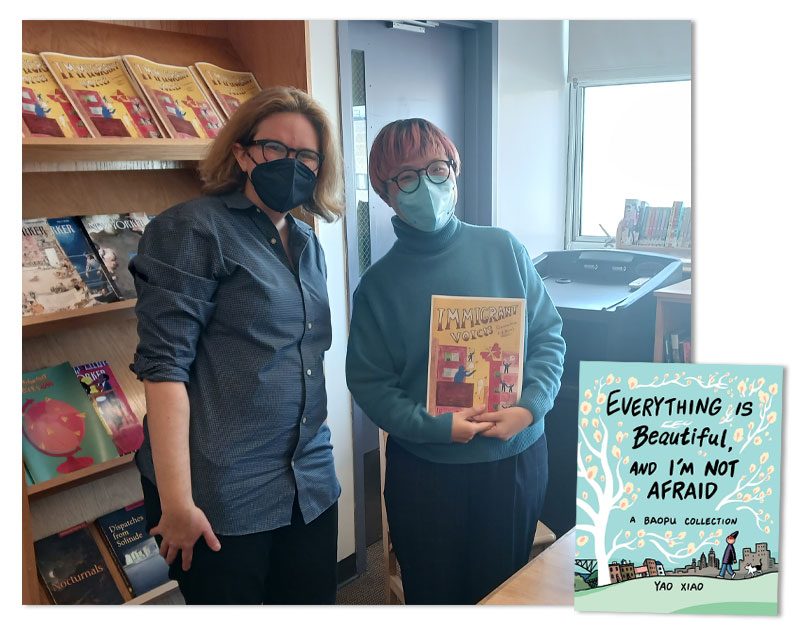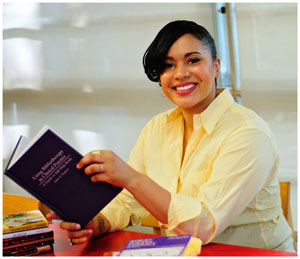“That’s How I Feel!” Visual Books Help Teens Grapple with Emotions and Mental Health
Illustrated works show the power of pictures to convey complex feelings—and why building a visual collection can be one of the best things you do for your teens.
 |
Illustration ©2022 by Molly Brooks. From Growing Pangs by Kathryn Ormsbee. Published by Random House Graphic. |
Related reading:"How to read wordless picture books with children" |
How can librarians build a mental health book collection that is engaging, welcoming, and maybe even funny? For me, that was a tall order. The teen self-help titles I purchased for my high school library were hit or miss; sometimes they seemed condescending. What kinds of books would help destigmatize mental health topics?
Illustrated ones, it turned out. My eureka moment occurred with Yao Xiao’s crossover adult-YA graphic novel Everything Is Beautiful, and I’m Not Afraid: A Baopu Collection (Andrews McMeel, 2020). In this story, a queer young Chinese immigrant grapples with identity, belonging, and big feelings that spread across full pages, exploding out of their comic boxes.
The comic-panel format is ideal for showing the narrator’s progression through therapy. She grows more resilient in every picture, alongside illustrations such as a whimsical turtle with googly eyes (marked “tough”) and a fragile flower (labeled “weak”). A propulsive page-turner, the book shows the power of pictures to illustrate complex feelings—and why building a visual collection in your library can be one of the best things you do for your teens.

How pictures work
In his classic comic theory book, Understanding Comics: The Invisible Art (Morrow, 1994), Scott McCloud asserts that humans naturally gravitate to symbols and icons. Comics have been around since the beginning of time, he points out: The first cave paintings and hieroglyphics in Egypt share similarities with the sequential art of the comic.
The simplicity of a comic, McCloud says, allows us to insert ourselves into the story and project our own feelings upon it, experiencing what he calls a “universal identification.”
Perhaps that’s why Raina Telgemeier’s brilliant graphic memoir Guts (Scholastic/Graphix, 2019), about a bright, sensitive girl whose anxiety leads to chronic gastrointestinal distress, was a runaway hit. Geared to ages 9–12, it offers a perfectly sensitive, age-appropriate investigation of the silent experiences of anxiety young children suffer alone.
In the same vein, Growing Pangs by Kathryn Ormsbee, illustrated by Molly Brooks (Random House Graphic, 2022), is an appealing, relatable story about a 10-year-old coping while a peer competes for her best friend’s attention. When Katie repetitively touches doorknobs or washes her hands, her distress seems tangible. Her intrusive thoughts are shown as a swarm of bees around her head, and Katie asserts, “My thoughts are not me.” Later, the character reaches out for help and gets counseling for her OCD.
I showed the illustration of the girl with bees when one of my students in the library was experiencing consuming thoughts and worries. “That’s how I feel!” she said, grateful to see her experience visualized. I am not sure she read the whole book. But I do know the illustration helped her feel seen and seek a guidance counselor meeting and counseling referral.
Veronica Agarwal and Lee Durfey-Lavoie’s Just Roll with It (Random House Graphic, 2021) is another story about OCD, featuring a South Asian family. The protagonist, new middle schooler Maggie, has a rich life packed with friends and activities. But readers also see her coping with anxiety by counting, flipping light switches, and rolling dice to help her make difficult decisions.
How does visual storytelling communicate differently than words? “When you’re watching a character go through it, you’re seeing the emotions on their face,” Sara Smith, a librarian at Sanger High School in rural California, said in an interview on the podcast The Literacy Advocate. Graphic novels feel closer to real life, so “we take on some of those emotions” of the characters, which builds empathy, noted Smith, who blogs at “The Graphic Librarian.”
Brian Selznick, creator of Big Tree and the Caldecott winner The Invention of Hugo Cabret (both Scholastic; 2023, 2007), and other illustrated books, has thought about this issue a lot.
“When deciding what to illustrate in Hugo, I’d already written a version of the story that was meant to have no pictures,” he says. “I went through the text and removed everything I thought could be successfully translated into pictures or picture sequences, like action and scene settings, and I imagined using close-ups, like in movies, to indicate important objects and moments in the story. I also found myself removing most descriptions of emotions, deciding to rely on pictures of the characters’ faces, so we could see them feeling those emotions.”
“There might a sense of freedom in looking at images that is different from reading text,” Selznick adds. “We all have to learn how to read, but we generally do not have to learn how to look at things. It comes instinctively.... But deciphering and understanding what we see is in fact a skill we can practice and get better at.”
Xiao says that “colors are very important to me, as a visual aspect and tool to illustrate mental health.” She describes being inspired by “silent comics,” such as Shaun Tan’s wordless picture book The Arrival (Arthur A. Levine, 2007). When reading or writing a comic, Xiao imagines a soundtrack. When there’s humor, she feels a “faster beat.” In comics using blank spaces, broad swaths of color, or full-bleed illustrations, she enters into a more immersive sound experience—from peace to panic. Emotions become “bigger” when the panels disappear and colors push out to the edges.
 |
Jess DeCourcy Hinds with Yao Xiao |
Close reading with teens
Ain’t Burned All the Bright by Jason Reynolds and Jason Griffin (Antheneum/Caitlyn Dlouhy, 2022) is an innovative, award-winning book about a Black family’s pandemic experience—and it’s composed of three sentences spread across collage-style illustrations. The images are “visceral” rather than “calming,” says IdaMae Craddock, librarian at the Community Lab School in Charlottesville, VA.
That’s exactly why Craddock and Community Lab school counselor Ouida Powe have used Ain’t Burned All the Bright in book-centered, social-emotional programs they lead together.
“I particularly chose this book...because our Black and brown students are disproportionately excluded from discussions of mental health,” Craddock wrote in an email, noting that in 2021 Black children under 13 were nearly twice as likely to die by suicide than white peers. The librarian-counselor partners find that Reynolds and Griffin’s book can “normalize talking about mental health” for their Black and brown students. Darrin Bell’s The Talk (Holt, 2023) a YA/adult crossover coming-of-age story in graphic format, explores the psychological manifestations of racism and also invites important conversations.
Craddock shared other observations from her experience focusing on books and mental health in the library.
“Books may not be the right tool mid-panic attack,” she noted. But “reading the book prior to the onset may provide the reader with tools to address a crisis moment.” Sometimes the librarian is the first person a student talks to “before the issue escalates,” she added.
Smith’s school psychology team is based in the library, and students often speak to her while waiting for a counselor. “Many of the students who talk to me about their anxiety admit that they often feel judged,” she says.
Many graphic novels can reduce this stigma with examples of characters seeking treatment. In Gender Queer by Maia Kobabe (Oni Pr., 2019), the narrator consults with a mental health practitioner and takes medicine for depression. Treatment doesn’t provide instant change, but the character gradually improves. Youth who are unfamiliar or uncomfortable with the mental health system may benefit from seeing such examples.
|
Visual connectionsBibliotherapist Emely Rumble, LCSW,has collaborated with school librarians and uses illustrated books in mental health counseling; she will teach an SLIS bibliotherapy course at Queens College, CUNY, this winter. Rumble recommends against librarians running bibliotherapy programs without a licensed mental health expert. But librarians can use some of her strategies in their approach to book selection and discussion. When selecting titles to read with students, Rumble advises that librarians choose ones where “the mental health struggle isn’t the full identity” of the character. She encourages young readers to flip through a book until they land on a page that speaks to them. This makes students feel as if they’re discovering the art in a self-directed way. To encourage students to interpret a wordless page, Rumble suggests, remain “as quiet as possible” so they can process visuals in their own way. Ask open-ended questions such as, “What do you notice on the first page?” Graphic novels and illustrated books can be a lifeline for students with limited attention spans or reading trauma, she notes. In “interactive bibliotherapy,” an adult may read with one or more teen. Illustrated books, with pictures that can be interpreted different ways, particularly lend themselves to group reading.—JDH |
Therapy stories with hopeful outcomes also include Xiao’s Everything Is Beautiful and Alison Bechdel’s Fun Home (Mariner, 2006). In reality, high-quality, affordable therapy can be very difficult to access. However, there is an impact in stories about people asking for help, whether the teen reaches out to a trusted adult, guidance counselor, family doctor, or crisis hotline.
Smith also recommends Lighter Than My Shadow by Katie Green (Turtleback, 2017) and The Dark Matter of Mona Starr by Laura Lee Gulledge (Abrams, 2020) because the characters’ psychological demons are shown as characters in their own right or physical beings, like the bees in Growing Pangs. If readers can feel sympathy for a comic book character, perhaps they can transfer that into self-compassion.
Visual games and popups
Xiao’s comic “What Are You Afraid of Bingo” is a lively checkered bingo board of fears that includes more serious topics like “cancer,” “food poisoning,” and “bed bugs,” along with lighter ones like “small talk,” “getting lost,” and “all-nighters.” As I read these to students in my creative writing class, we laughed and nodded in recognition.
I invited my class to make our own bingo boards, and everyone was engrossed in drawing. They all volunteered to share. I spoke about my fears first to break the ice, and then students jumped in. Voicing anxieties made us feel less isolated, especially since many share the same fears.
Games like bingo—and playful 3-D books—can be powerful tools in supporting mental health. Pop-up titles like Beautiful Oops! by Barney Saltzberg (Workman, 2010) can impart pure joy. Although geared to ages three and up, Saltzberg’s messages that “mistakes” are not always mistakes is valuable for all ages. The book is a 3-D work of art, with flaps, tabs, and peek-through holes. When a student is being hard on herself or self-critical, I let her play with Beautiful Oops! It has a meditative and affirming effect.
Children and tweens alike will be mesmerized by 3-D books such as Alice’s Adventures in Wonderland: A Popup Adaptation of Lewis Carroll’s Original Tale by illustrator Robert Sabuda (S. & S./Little Simon, 2003), who has created pop-up versions of classic stories and fairy tales including Beauty & the Beast. Popups invite group interaction and exploration, not solitary reading. The books are about personal journeys, and like all fairy tales, give us a safe space to wrestle with our darkest fears and then find safety.
As Selznick muses, an “image allows us to project ourselves into the subject and fill in something from our own lives in a way that might be more powerful and direct.... This is why whenever someone says to me, ‘I feel like you made this book just for me,’ I answer, ‘I did.’”
Jess DeCourcy Hinds is the librarian at Sojourner Truth School in New York City.
RELATED
The job outlook in 2030: Librarians will be in demand
The job outlook in 2030: Librarians will be in demand
ALREADY A SUBSCRIBER? LOG IN
We are currently offering this content for free. Sign up now to activate your personal profile, where you can save articles for future viewing







Add Comment :-
Be the first reader to comment.
Comment Policy:
Comment should not be empty !!!